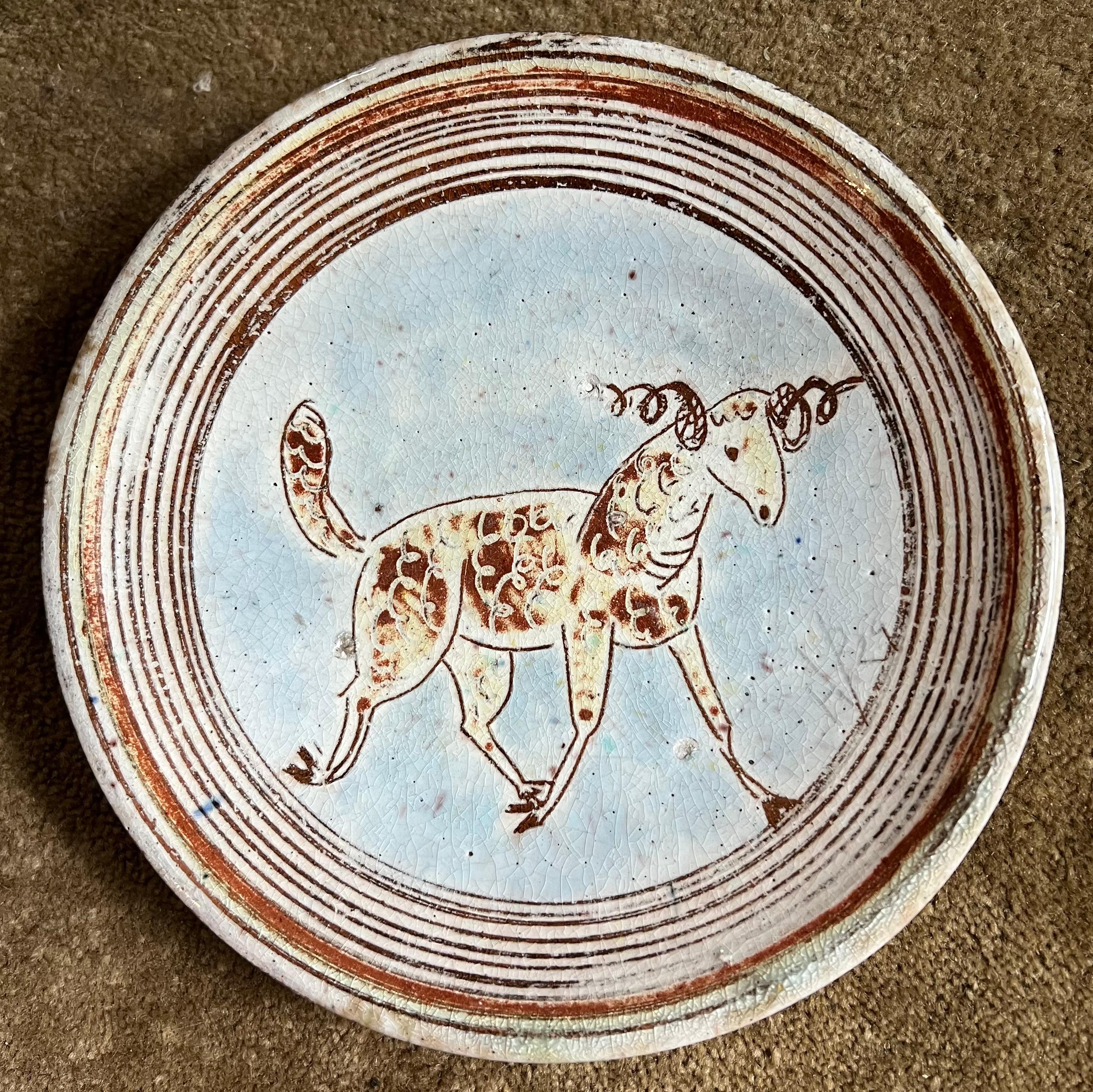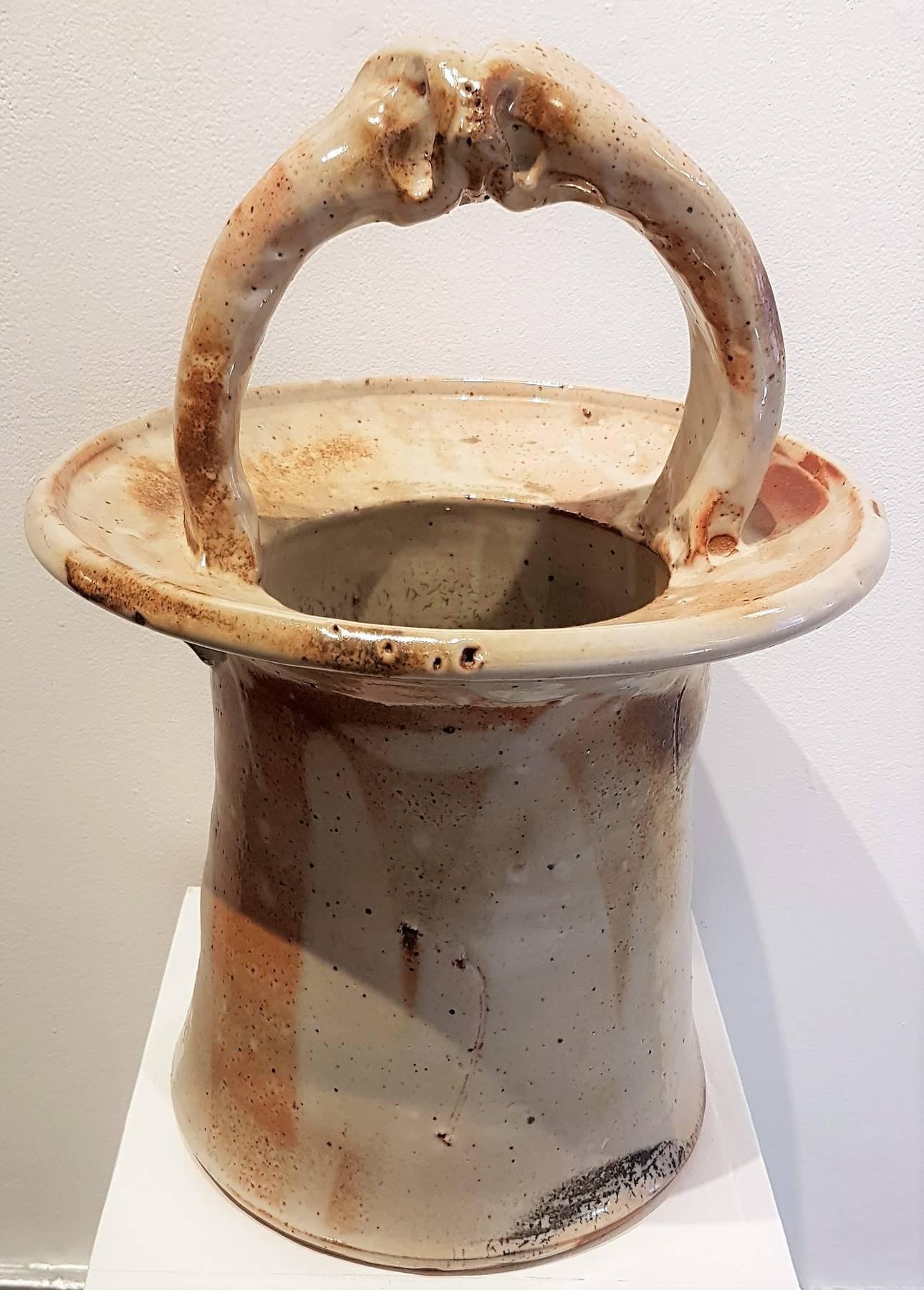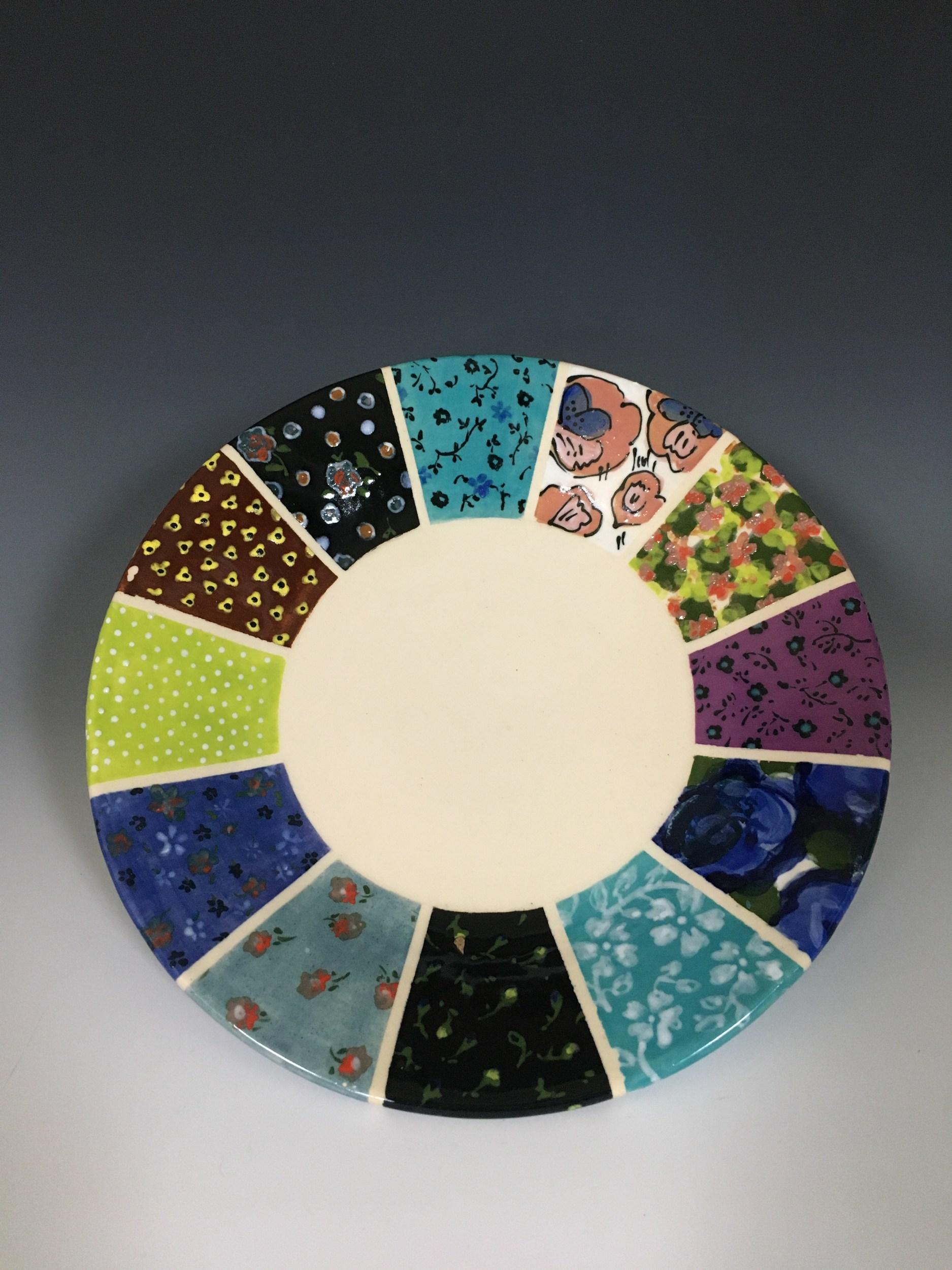Items Similar to Aldo Londi Vase Abstract "Glass Fused Ceramic Vase"
Want more images or videos?
Request additional images or videos from the seller
1 of 6
Aldo Londi Aldo Londi Vase Abstract "Glass Fused Ceramic Vase"Circa 1950
Circa 1950
About the Item
SALE ONE WEEK ONLY
"Glass Fused Ceramic Vase" is vintage Mid-Century Modern. This handsome vase has an elongated neck with a white glass-fused inlay portion on the front body providing the perfect background and crisp contrast to the rich umber brown wash of the entire piece. A soft transparent glaze over the wash enhances the piece and adds a subdued luster. Dashes of red glaze in strategic locations make the entire piece sparkle. This vase is unique in that the color is mainly a rich earth tone, a color not used as frequently once Londi developed the Rimini Blu glaze. Provenance is on Verso.
Aldo Londi was born in Montelupo, Florence. Montelupo Fiorentino is a comune in the Metropolitan City of Florence in the Italian region Tuscany, located about 20 kilometres southwest of Florence. Londi became one of the leading pottery designers of the times. He ventured into pottery at the age of 11 years when he secured his first job at a local ceramic manufacturing company. Even though he was imprisoned between 1935 and 1943 in Johannesburg, Africa, as a prisoner of war, he continued his quest for the art. Post Second World War, 1946, he became the Art Director of the renowned Bitossi studio in Montelupo, Florence, where he held the position for 50 years and created thousands of designs for vases, jugs, animals, candlestick holders and other objects.
Londi’s art flourished at Bitossi’s and he designed numerous motifs and sculptures. He created a new range of pottery by merging together layers of turquoise and blue. The range was named Rimini Blu, after the road junction connecting Northern and Central Italy.
- Creator:Aldo Londi (1911 - 2003)
- Creation Year:Circa 1950
- Dimensions:Height: 16.5 in (41.91 cm)Width: 9 in (22.86 cm)
- Medium:
- Movement & Style:
- Period:
- Condition:
- Gallery Location:Detroit, MI
- Reference Number:1stDibs: LU128615258722
About the Seller
5.0
Gold Seller
These expertly vetted sellers are highly rated and consistently exceed customer expectations.
Established in 2014
1stDibs seller since 2019
95 sales on 1stDibs
Typical response time: 3 hours
- ShippingRetrieving quote...Ships From: Detroit, MI
- Return PolicyA return for this item may be initiated within 14 days of delivery.
More From This SellerView All
- John Glick Plum Street Pottery Reduction Fired Shino Glaze Cup Published in BookLocated in Detroit, MI“Untitled” ceramic, is an example of the kind of work by which John Glick became so famous. He was seduced by the effects of the reduction kiln, which decreased the levels of oxygen during firing, inducing the flame to pull oxygen out of the clay and glazes changing the colors of the glazes depending on their iron and copper content. In this way he achieved the rich gradients of ochre and umber and variations in stippling and opacity. This piece is signed on the bottom and can be found on page 92, plate #125 in “John Glick: A Legacy in Clay.” John was an American Abstract Expressionist ceramicist born in Detroit, MI. Though open to artistic experimentation, Glick was most influenced by the styles and aesthetics of Asian pottery—an inspiration that shows in his use of decorative patterns and glaze choices. He has said that he is attracted to simplicity, as well as complexity: my work continually reflects my re-examination that these two poles can coexist… or not, in a given series. Glick also took influences from master potters of Japan, notably Shoji Hamada and Kanjrio Kawai, blending their gestural embellishments of simple forms with attitudes of Abstract Expressionism. He was particularly drown to the work of Helen Frankenthaler whose soak-stain style resonated with Glick’s multi-layered glaze surfaces, which juxtaposed veils of atmospheric color with gestural marks and pattern. He spent countless hours developing and making his own tools in order to achieve previously unseen results in his work with clay and glaze. Glick’s “Plum Tree Pottery...Category
1990s American Modern More Art
MaterialsStoneware, Glaze
- "Untitled" Ceramic Vase with Etched Figures, Green Glaze, Signed on BottomLocated in Detroit, MISALE ONE WEEK ONLY Douglas’s etched ceramic vase in a rich earthy green glaze expresses the Mid-Century Modern style of simplicity of lines, forms and color. Despite its formal shap...Category
Mid-20th Century American Modern More Art
MaterialsCeramic, Glaze
- John Glick Plum Tree Pottery , Stoneware Mug, Deep Earth Tones, GlazedLocated in Detroit, MI“Untitled” ceramic, is an example of the kind of work by which John Glick became so famous. He was seduced by the effects of the reduction kiln, which decreased the levels of oxygen during firing, inducing the flame to pull oxygen out of the clay and glazes changing the colors of the glazes depending on their iron and copper content. In this way he achieved the rich gradients of ochre and umber and variations in stippling and opacity. This piece is signed on the bottom and can be found on page 129, plate #236 in “John Glick: A Legacy in Clay.” John was an American Abstract Expressionist ceramicist born in Detroit, MI. Though open to artistic experimentation, Glick was most influenced by the styles and aesthetics of Asian pottery—an inspiration that shows in his use of decorative patterns and glaze choices. He has said that he is attracted to simplicity, as well as complexity: my work continually reflects my re-examination that these two poles can coexist… or not, in a given series. Glick also took influences from master potters of Japan, notably Shoji Hamada and Kanjrio Kawai, blending their gestural embellishments of simple forms with attitudes of Abstract Expressionism. He was particularly drown to the work of Helen Frankenthaler whose soak-stain style resonated with Glick’s multi-layered glaze surfaces, which juxtaposed veils of atmospheric color with gestural marks and pattern. He spent countless hours developing and making his own tools in order to achieve previously unseen results in his work with clay and glaze. Glick’s “Plum Tree Pottery...Category
Late 20th Century American Modern More Art
MaterialsStoneware, Glaze
- John Glick Plum Street Pottery Glazed Bowl Reduction FiredLocated in Detroit, MI"Untitled" is a stoneware piece with the decorative layer of the rich toned glazes and markings that John was so well-known for. Each piece that John produced was unique. The lip on this piece is slightly scalloped and the shape is removed from the boring circular to mimic a gentle geometric design. He was seduced by the effects of the reduction kiln, which decreased the levels of oxygen during firing, inducing the flame to pull oxygen out of the clay and glazes changing the colors of the glazes depending on their iron and copper content. In this way he achieved the rich gradients of ochre and umber and variations in stippling and opacity. This piece is signed and stamped on the bottom. John was an American Abstract Expressionist ceramicist born in Detroit, MI. Though open to artistic experimentation, Glick was most influenced by the styles and aesthetics of Asian pottery—an inspiration that shows in his use of decorative patterns and glaze choices. He has said that he is attracted to simplicity, as well as complexity: my work continually reflects my re-examination that these two poles can coexist… or not, in a given series. Glick also took influences from master potters of Japan, notably Shoji Hamada and Kanjrio Kawai, blending their gestural embellishments of simple forms with attitudes of Abstract Expressionism. He was particularly drown to the work of Helen Frankenthaler whose soak-stain style resonated with Glick’s multi-layered glaze surfaces, which juxtaposed veils of atmospheric color with gestural marks and pattern. He spent countless hours developing and making his own tools in order to achieve previously unseen results in his work with clay and glaze. Glick’s “Plum Tree Pottery...Category
1970s American Modern Abstract Sculptures
MaterialsStoneware, Glaze
- Magnificent John Glick Plum Street Pottery "Scalloped Box" Glazed StonewareLocated in Detroit, MIThis magnificent "Scalloped Box" is a stoneware piece with decorative layers of rich toned glazes and markings that John was so well-known for. He was, also, known for the undulating lip lines on his exquisite boxes that fit together like a puzzle. Each piece that John produced was unique. He was seduced by the effects of the reduction kiln, which decreased the levels of oxygen during firing, inducing the flame to pull oxygen out of the clay and glazes thereby changing the colors of the glazes depending on their iron and copper content. In this way he achieved the rich gradients of ochre and umber and variations in stippling and opacity. This piece is signed and stamped on the bottom. John was an American Abstract Expressionist ceramicist born in Detroit, MI. Though open to artistic experimentation, Glick was most influenced by the styles and aesthetics of Asian pottery—an inspiration that shows in his use of decorative patterns and glaze choices. He has said that he is attracted to simplicity, as well as complexity: my work continually reflects my re-examination that these two poles can coexist… or not, in a given series. Glick also took influences from master potters of Japan, notably Shoji Hamada and Kanjrio Kawai, blending their gestural embellishments of simple forms with attitudes of Abstract Expressionism. He was particularly drown to the work of Helen Frankenthaler whose soak-stain style resonated with Glick’s multi-layered glaze surfaces, which juxtaposed veils of atmospheric color with gestural marks and pattern. He spent countless hours developing and making his own tools in order to achieve previously unseen results in his work with clay and glaze. Glick’s “Plum Tree Pottery...Category
Late 20th Century American Modern Abstract Sculptures
MaterialsStoneware, Glaze
- Breathtaking John Glick "Scalloped Basket" Glazed Stoneware Reduction FiredLocated in Detroit, MI"Scalloped Basket" is a stoneware piece with the decorative layer of the rich toned glazes and markings that John was so well-known for. He was, also, known for the undulating lip lines on his exquisite pieces. The basket portion is shaped with gentle curves and a sculptural handle. Each piece that John produced was unique. He was seduced by the effects of the reduction kiln, which decreased the levels of oxygen during firing, inducing the flame to pull oxygen out of the clay and glazes changing the colors of the glazes depending on their iron and copper content. In this way he achieved the rich gradients of ochre and umber and variations in stippling and opacity. This particular "basket" also has the cool blues and grays that contrast with the umber. It is signed and stamped on the bottom. John was an American Abstract Expressionist ceramicist born in Detroit, MI. Though open to artistic experimentation, Glick was most influenced by the styles and aesthetics of Asian pottery—an inspiration that shows in his use of decorative patterns and glaze choices. He has said that he is attracted to simplicity, as well as complexity: my work continually reflects my re-examination that these two poles can coexist… or not, in a given series. Glick also took influences from master potters of Japan, notably Shoji Hamada and Kanjrio Kawai, blending their gestural embellishments of simple forms with attitudes of Abstract Expressionism. He was particularly drown to the work of Helen Frankenthaler whose soak-stain style resonated with Glick’s multi-layered glaze surfaces, which juxtaposed veils of atmospheric color with gestural marks and pattern. He spent countless hours developing and making his own tools in order to achieve previously unseen results in his work with clay and glaze. Glick’s “Plum Tree Pottery...Category
1970s American Modern Abstract Sculptures
MaterialsStoneware, Glaze
You May Also Like
- Plate with Ram (Untitled)By Henry Varnum PoorLocated in Los Angeles, CA(Note: This work is part of our exhibition Connected by Creativity: WPA Era Works from the Collection of Leata and Edward Beatty Rowan) Glazed and incised ceramic, 8 ½ inches diamet...Category
1920s American Modern More Art
MaterialsCeramic
- Particle VIII (Eight)By Brady McLearenLocated in Kansas City, MOParticle VIII (Eight) Materials: Ceramic, glaze Year: 2016 The formal languages and frequencies that we find in the natural existence of the universe inform and inspire the investig...Category
2010s American Modern More Art
MaterialsCeramic, Glaze
- Basket with handleBy Ken FergusonLocated in Kansas City, MOKen Ferguson Basket with handle Material: Stoneware, glaze Year: Circa 1980 Size: 18 x 13 inches Stamped Kenneth Richard Ferguson was an American c...Category
1980s American Modern More Art
MaterialsStoneware, Glaze
- Brown 10 Petal PlateBy Rachel Hubbard KlineLocated in Kansas City, MORachel Hubbard Kline Brown 10 Petal Plate Medium: Stoneware, underglaze, glaze Year: 2021 Size: 1 1/4" x 7 3/4" x 7 3/4" Description: Wheel-thrown plate wi...Category
2010s American Modern More Art
MaterialsStoneware, Glaze, Underglaze
- Twelve Pattern PlateBy Rachel Hubbard KlineLocated in Kansas City, MORachel Hubbard Kline Twelve Pattern Plate Medium: Stoneware, underglaze, glaze Year: 2021 Size: 1 1/2" x 8" x 8" Description: Wheel-thrown plate with hand-painted textile pattern -...Category
2010s American Modern More Art
MaterialsGlaze, Underglaze, Stoneware
- Museum Quality Shino platter by Warren MacKenzieBy Warren MacKenzieLocated in Morton Grove, ILWarren MacKenzie Finger Swiped Shino Platter approx 3.5 x 19.75 x 19.75" Stoneware and glaze date unknown Possibly stamped under the glaze but cannot see the MA mark.Category
1990s American Modern More Art
MaterialsStoneware, Glaze
Recently Viewed
View AllMore Ways To Browse
Brown Wash
Modern American Art Glass
Vintage Midcentury Pottery
Post Modern Ceramic
Vintage Ceramic Art
Glass Fused
Vintage Midcentury Turquoise
Turquoise Art Glass
Southwest Modern
Quest Modern
Modern Southwest Art
Retro Southwest Art
Post Modern Motif
Vintage Red Ceramic
Art By Aldo
Ceramic Florence
African American Mid Century Art
Fused Art Glass




